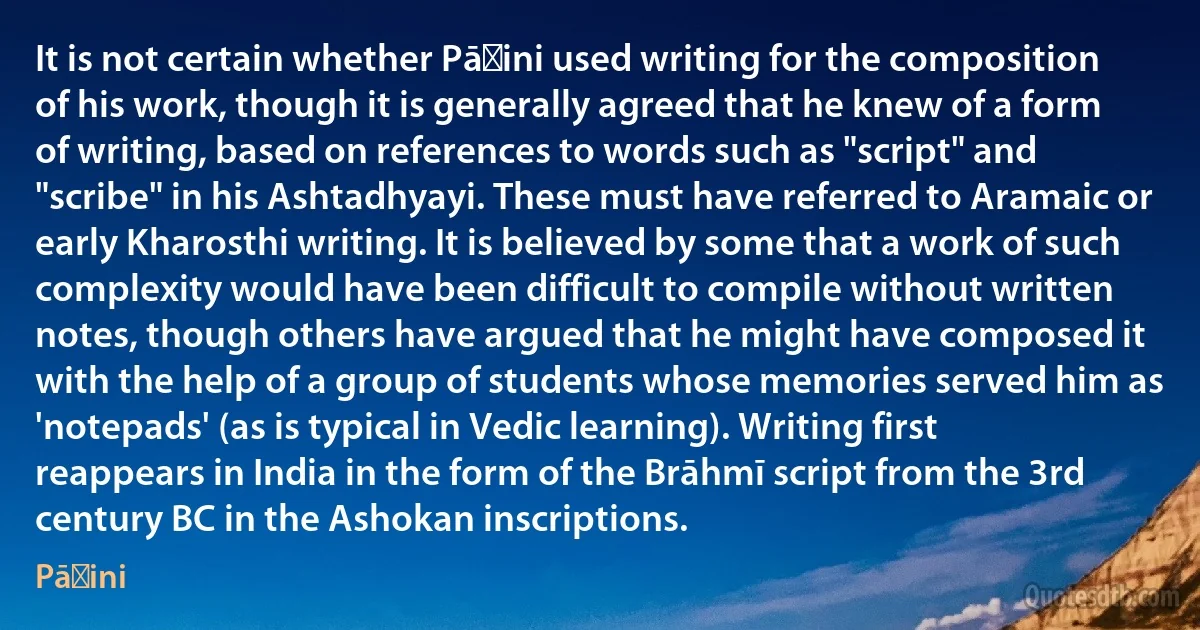
It is not certain whether Pāṇini used writing for the composition of his work, though it is generally agreed that he knew of a form of writing, based on references to words such as "script" and "scribe" in his Ashtadhyayi. These must have referred to Aramaic or early Kharosthi writing. It is believed by some that a work of such complexity would have been difficult to compile without written notes, though others have argued that he might have composed it with the help of a group of students whose memories served him as 'notepads' (as is typical in Vedic learning). Writing first reappears in India in the form of the Brāhmī script from the 3rd century BC in the Ashokan inscriptions.
PāṇiniRelated topics
century certain compile complexity composition early form help learning might script typical work write others words notes paniniRelated quotes
The inversion theory has a long and fascinating history in the discussion of vertebrate origins. The founding version dates to the early nineteenth century and became the centerpiece of a movement often called "transcendental biology," and centered on the attempt to reduce organic diversity to one or a very few archetypal building blocks that could generate all actual anatomies as products of rational laws of transformation. Some of Europe's greatest thinkers participated in this grand, if flawed enterprise. Goethe, Germany's preeminent poet-scientist, tried to explain the varied parts of plants as different manifestations of an archetypal leaf.

Stephen Jay Gould
A willingness to satisfy contradictory objections to one's manner of writing might turn one's work into the donkey that finally found itself being carried by its masters, since some readers suggest that quotation marks are disruptive of pleasant progress; others, that notes to what should be complete are a pedantry or evidence of an insufficiently realized task. But since in anything I have written, there have been lines in which the chief interest is borrowed, and I have not yet been able to outgrow this hybrid method of composition, acknowledgements seem only honest. Perhaps those who are annoyed by provisos, detainments, and postscripts could be persuaded to take probity on faith and disregard the notes.

Marianne Moore
I am here today, I may not be here tomorrow. But the responsibility to look after national interest is on the shoulder of every citizen of India. I have often mentioned this earlier. Nobody knows how many attempts have been made to shoot me, lathis have been used to beat me. In Bhubaneswar itself, a brickbat hit me. They have attacked me in every possible manner. I do not care whether I live or die. I have lived a long life and I am proud that I spend the whole of my life in the service of my people. I am only proud of this and nothing else. I shall continue to serve until my last breath and when I die, I can say, that every drop of my blood will invigorate India and strengthen it.

Indira Gandhi
Don't you drink I notice you speak slightingly of the bottle. I have drunk since I was fifteen and few things have given me more pleasure. When you work hard all day with your head and know you must work again the next day what else can change your ideas and make them run on a different plane like whisky When you are cold and wet what else can warm you Before an attack who can say anything that gives you the momentary well-being that rum does The only time it isn't good for you is when you write or when you fight. You have to do that cold. But it always helps my shooting. Modern life, too, is often a mechanical oppression and liquor is the only mechanical relief.

Ernest Hemingway
The gospel freely admitted makes a man happy. It gives him peace with God, and makes him happy in God. It gives to industry a noble, contented look which selfish drudgery never wore; and from the moment that a man begins to do his work for his Saviour's sake, he feels that the most ordinary employments are full of sweetness and dignity, and that the most difficult are not impossible. And if any of you, my friends, is weary with his work, if dissatisfaction with yourself or sorrow of any kind disheartens you, if at any time you feel the dull paralysis of conscious sin, or the depressing influence of vexing thoughts, look to Jesus, and be happy. Be happy, and your joyful work will prosper well.

William Wilberforce
